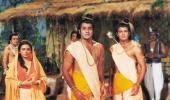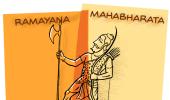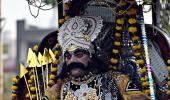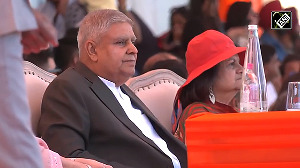There is definitely much more to the mythical king than his ten heads and his abduction of Sita.
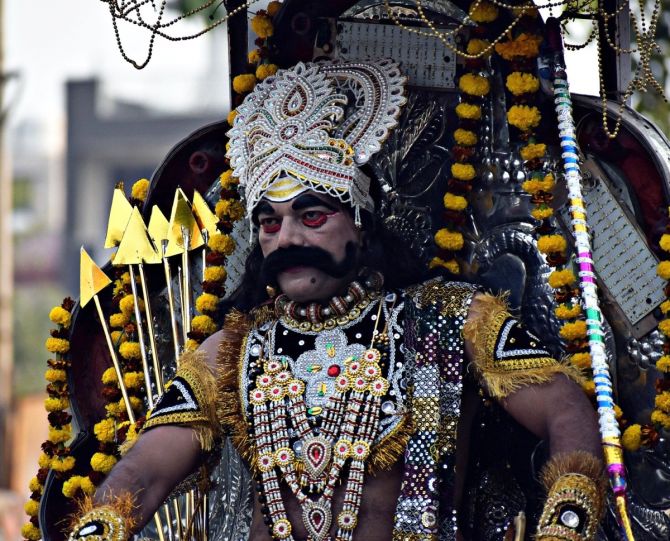
The Ramayana needs little introduction to anyone in India. But unlike its hero Rama, who has aged remarkably well and whose image has become a symbol of resurgent nationalism in the country, the defeated king of Lanka, Ravana, has paled into a cardboard version of himself.
Demonic and devilish, his only place in the popular imagination in India is as a flaming effigy crumbling in the fire.
There is definitely much more to the mythical king than his ten heads and his abduction of Sita. And that is what this book by Sunela Jayewardene attempts to discover, by holding him up to a different mirror.
It offers a new perspective on Ravana and examines the role that his life and legend have had on the evolution of the island nation of Lanka.
An architect by training, Jayewardene's approach is refreshing. She trawls through old texts and religious scriptures, sifts through archaeological evidence and uses her country's rich folkloric traditions to put together a nuanced portrayal of Ravana.
She also looks at him outside of the typical mythological frameworks that he has always been placed within; tracing his emergence instead, to the earliest inhabitants of her country.
She sets the context for her research by saying that Sri Lanka, like the rest of the subcontinent, has had vast swathes of its past erased under colonial rule.
Its textual and oral traditions were either discarded or belittled. For years, British historians even claimed that there was no island nation before they colonised the region under the name of Ceylon.
All of this has led to a huge deficit in the historical and archaeological research work in the country.
Keen to change the narrative, Jayewardene pieces together an alternative story using travellers' accounts, folk tales, subcontinental history and archaeological and genetic studies.
She dips into multiple sources to draw the picture of a nation and a king, whose mythologies have long overpowered reality.

Ravana, Jayewardene writes, belonged to the Mayuranga dynasty of the Yakas, one of the earliest settlers on the island.
This dynasty ruled over ten states and that is perhaps how Ravana earned his unique moniker as the king with ten heads.
She traces his presence to the southeastern end of Lanka, in the Kumana region. The place today is a national park and a tourist spot.
This is where the ancient Yakas set up their kingdom, the tribe that gave rise to the Mayuranga dynasty, and Ravana.
The Yakas were one of three ancient tribes that peopled the island, the two others being Rakusa and Naga.
All three set down a fascinating trajectory of migration, genetic mingling and cultural exchange in the island.
According to the author, the Rakusa tribespeople were hunter-gatherers. Their name is synonymous with that of the Veddhas, the forest-dwelling tribes of Sri Lanka.
The term Rakusa means protector in languages that emerge out of both Dravidian- and Sanskrit-speaking parts of the region and is corrupted as Rakshasa in most Indian languages.
The Naga tribe was believed to have been a maritime community. Hardy seafarers, their reputation for sailing through rough and stormy seas gave them legendary status and helped them establish very powerful kingdoms.
The Nagas and Rakusas were both influential in the emergence of Ravana as an all-powerful king in the region.

The book traces his reign to the Kumana region using a mix of archaeological finds and the abundant regional legends and folklore around him.
For instance, a rock inscription in Kumana, at least 2,000 years old, reads: Great lord Ravana's daughter Shohili gifts her cave to the Sangha.
Such finds are strewn across the landscape, writes Jayewardene, but local authorities are reluctant to wade deeper or investigate further.
After all, she writes, the cave of Ravana's daughter ought to have been researched and excavated further, but it has been largely left unexamined.
Like much of the renewed interest in the ancient past of the subcontinent, such exercises are highly political.
Sometimes there is a deep reluctance to shake off the colonial overhang over such research.
It could also be the political exigency of sticking to or creating narratives that generate national pride and unity. It could also be a scarcity of local talent interested in the issues.
Using folklore and mythology in an evidence-based examination of the past is never easy.
Jayewardene is aware of this and wisely stays away from finger-pointing exercises.
That is perhaps why the research that she has put together is remarkable and ought to generate more work on the subject.
The only thing that one would have liked in the book is a better editor. Spelling mistakes, loose sentences and repetition take away from an otherwise interesting read.
Ravana's Lanka: The Landscape Of A Lost Kingdom
Author: Sunela Jayewardene
Publisher: Penguin Vintage
Pages: 336
Price: Rs 499
Feature Presentation: Rajesh Alva/Rediff.com

